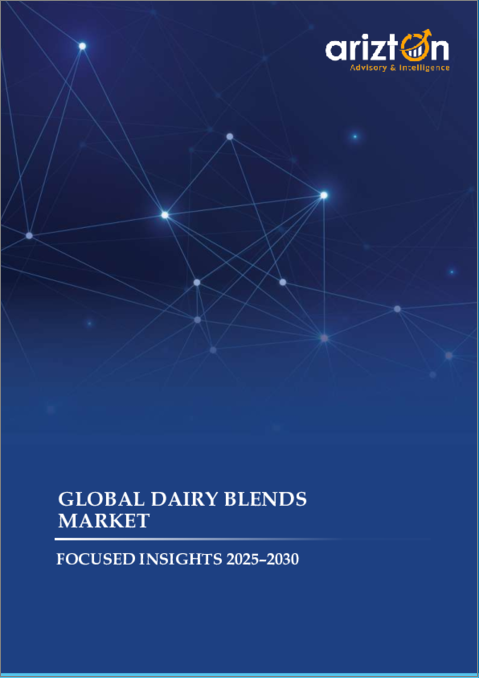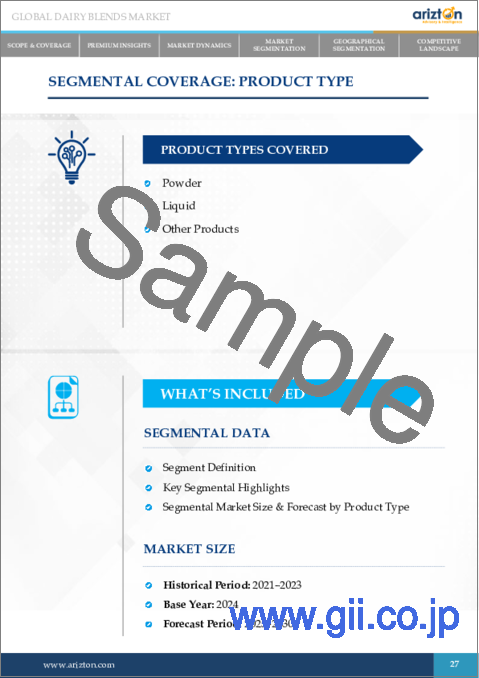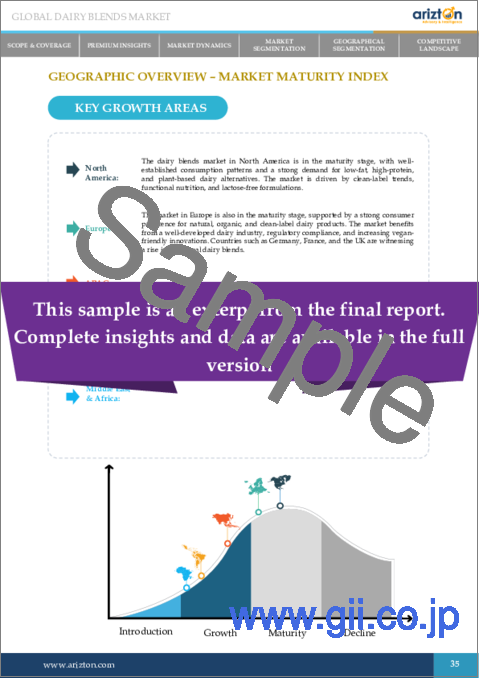|
|
市場調査レポート
商品コード
1688850
乳製品ブレンドの世界市場:注目の洞察(2025年~2030年)Global Dairy Blends Market - Focused Insights 2025-2030 |
||||||
|
|||||||
| 乳製品ブレンドの世界市場:注目の洞察(2025年~2030年) |
|
出版日: 2025年03月26日
発行: Arizton Advisory & Intelligence
ページ情報: 英文 117 Pages
納期: 即納可能
|
全表示
- 概要
- 図表
- 目次
世界の乳製品ブレンドの市場規模は、2024年から2030年にかけて3.90%のCAGRで拡大すると予測されています。
2024年3月、Kerry Dairyはオーツ麦と乳製品をブレンドし、両原料の栄養的利点を組み合わせた新シリーズを発売しました。この革新的な製品ラインは、味や食感に妥協することなく、植物由来の代替品を求める消費者により持続可能で包括的な選択肢を提供することを目的としています。オート麦と乳製品のブレンドは、植物由来のひねりを加えた乳製品体験を提供するよう設計されており、多様な食生活の嗜好に対応し、製品の多様性を高めます。今回の発売は、ケリー乳業の持続可能性へのコミットメントを反映したもので、より多用途で環境に優しい食品を求める消費者の要望に応えるものです。
2024年2月、Fonterra Co-operative Group Ltd.は、オーストラリアとニュージーランドの乳製品事業(Fonterra AustraliaとFonterra Brands New Zealand)を統合する差し迫った計画を発表しました。この戦略的統合構想により、この地域における同社の地位はさらに強化される見込みです。
メーカーは、進化する消費者の嗜好に対応するため、多様でユニークなフレーバーを導入しています。人気の動向には、フルーツを使ったフレーバー(ストロベリーやマンゴーなど)、デザートにヒントを得たオプション(キャラメルやチョコレートなど)、ボタニカルフレーバー(ラベンダーや抹茶など)などがあります。ネスレやダノンなどの大手ブランドは、消費者へのアピールを高めるため、天然エキスを配合したフレーバー乳製品を発売しています。ナチュラルでオーガニックなフレーバーへの需要が高まるにつれ、ブランドはクリーンラベルの原料を使用するようになっています。カスタマイズされたフレーバー乳製品ブレンドは、ヨーグルト、ベーカリー製品、レディ・トゥ・ドリンク飲料で人気を集めています。
乳製品ブレンドは、植物由来の代替食肉、機能性食品、ペット用栄養食品への配合が増加しています。その多用途性は食感を高め、風味を改善し、様々な食品カテゴリーに栄養強化を提供します。高タンパク質の乳製品ブレンドは、スポーツ栄養製品やタンパク質強化飲料で人気を集めています。さらに、消費習慣の変化により、風味の良い乳製品入りスナックや調理済み食品の需要が高まっています。FrieslandCampinaやKerry Groupなどの主要企業は、従来とは異なる用途向けの革新的な乳製品配合に投資しています。
拡大する食品・飲料業界は、特に加工食品、ベーカリー、菓子類における乳製品ブレンドの需要を牽引しています。マクドナルドやバーガーキングのようなファーストフードチェーンは、チーズベースの製品、ソース、デザートに乳製品ブレンドを利用しており、市場の成長をさらに促進しています。北米や欧州などの地域では、調理済み食品の需要が高まっているため、メーカー各社は保存期間の延長や食感の改善のために乳製品ブレンドを取り入れるようになっています。ネスレやモンデリーズをはじめとする大手食品会社は、全乳やクリームに代わる費用対効果の高い代替品として乳製品ブレンドを製品に採用しています。一方、インドやブラジルなどの新興国では、都市化の進展と中流階級の人口増加により、乳製品の消費が急増しています。
消費者は乳製品に栄養面でのメリットを求めるようになっており、高タンパク低脂肪乳製品ブレンドの成長を牽引しています。フェアライフやヨープレイトのようなブランドは、腸の健康をサポートするためにカルシウム、ビタミン、プロバイオティクスを強化した乳製品ブレンドを発売しています。乳糖不耐症の消費者は、低乳糖や無乳糖の乳製品ブレンドの需要に拍車をかけており、特殊な乳製品製剤の市場を押し上げています。さらに、スポーツ・フィットネス業界は、マッスルミルク(Muscle Milk)やオプティマムニュートリション(Optimum Nutrition)などの主要企業を中心に、タンパク質強化乳製品ブレンドの需要を加速させています。APAC地域、特に日本と韓国における健康志向の動向は、食事代替や飲料における機能性乳製品ブレンドの需要をさらに促進しています。
当レポートでは、世界の乳製品ブレンド市場について調査し、市場の概要とともに、製品タイプ別、用途別、地域別の動向、および市場に参入する企業のプロファイルなどを提供しています。
目次
第1章 世界の乳製品ブレンド市場概要
- エグゼクティブサマリー
- 主な調査結果
- 主な発展
第2章 世界の乳製品ブレンド市場セグメンテーションデータ
- 製品タイプ別市場の洞察(2021年~2030年)
- 液体
- 粉末
- その他
- 用途別市場の洞察(2021年~2030年)
- 食品・飲料部門
- 非食品・飲料部門
第3章 世界の乳製品ブレンド市場の見通しと機会
- 世界の乳製品ブレンド市場の促進要因
- 世界の乳製品ブレンド市場の動向
- 世界の乳製品ブレンド市場の抑制要因
第4章 世界の乳製品ブレンド市場概要
- 世界の乳製品ブレンド市場-競合情勢
- 世界の乳製品ブレンド市場- 主要参入企業
- 世界の乳製品ブレンド市場- 主要企業プロファイル
第5章 付録
LIST OF EXHIBITS
- EXHIBIT 1 Global Dairy Blends Market 2021-2030 ($ Billion)
- EXHIBIT 2 Global Dairy Blends Market by Powder 2021-2030 ($ Billion)
- EXHIBIT 3 Global Dairy Blends Market by Liquid 2021-2030 ($ Billion)
- EXHIBIT 4 Global Dairy Blends Market by Others 2021-2030 ($ Billion)
- EXHIBIT 5 Global Dairy Blends Market by Food & Beverage Sector 2021-2030 ($ Billion)
- EXHIBIT 6 Global Dairy Blends Market By Non-Food & Beverage Sector 2021-2030 ($ Billion)
- EXHIBIT 7 Dairy Blends Market in APAC 2021-2030 ($ Billion)
- EXHIBIT 8 Dairy Blends Market in China 2021-2030 ($ Million)
- EXHIBIT 9 Dairy Blends Market in India 2021-2030 ($ Million)
- EXHIBIT 10 Dairy Blends Market in Japan 2021-2030 ($ Million)
- EXHIBIT 11 Dairy Blends Market in Indonesia 2021-2030 ($ Million)
- EXHIBIT 12 Dairy Blends Market in North America 2021-2030 ($ Billion)
- EXHIBIT 13 Dairy Blends Market in The US 2021-2030 ($ Million)
- EXHIBIT 14 Dairy Blends Market in Canada 2021-2030 ($ Million)
- EXHIBIT 15 Dairy Blends Market in Europe 2021-2030 ($ Billion)
- EXHIBIT 16 Dairy Blends Market in Germany 2021-2030 ($ Million)
- EXHIBIT 17 Dairy Blends Market in The UK 2021-2030 ($ Million)
- EXHIBIT 18 Dairy Blends Market in France 2021-2030 ($ Million)
- EXHIBIT 19 Dairy Blends Market in Italy 2021-2030 ($ Million)
- EXHIBIT 20 Dairy Blends Market in Latin America 2021-2030 ($ Billion)
- EXHIBIT 21 Dairy Blends Market in Brazil 2021-2030 ($ Million)
- EXHIBIT 22 Dairy Blends Market in Mexico 2021-2030 ($ Million)
- EXHIBIT 23 Dairy Blends Market in Argentina 2021-2030 ($ Million)
- EXHIBIT 24 Dairy Blends Market in The Middle East & Africa 2021-2030 ($ Billion)
- EXHIBIT 25 Dairy Blends Market in Turkey 2021-2030 ($ Million)
- EXHIBIT 26 Dairy Blends Market in Saudi Arabia 2021-2030 ($ Million)
LIST OF TABLES
- TABLE 1 Global Dairy Blends Market by Product Type (2021-2023) ($ Billion)
- TABLE 2 Global Dairy Blends Market by Product Type (2024-2030) ($ Billion)
- TABLE 3 Global Dairy Blends Market by Application (2021-2023) ($ Billion)
- TABLE 4 Global Dairy Blends Market by Application (2024-2030) ($ Billion)
- TABLE 5 Global Dairy Blends Market by Geography 2021-2023 ($ Billion)
- TABLE 6 Global Dairy Blends Market by Geography 2024-2030 ($ Billion)
The global dairy blend market is expected to grow at a CAGR of 3.90% from 2024 to 2030.
RECENT VENDOR ACTIVITIES
- In March 2024, Kerry Dairy launched a new range of oat and dairy-blended products, combining the nutritional benefits of both ingredients. This innovative product line aims to provide a more sustainable and inclusive option for consumers seeking plant-based alternatives without compromising on taste or texture. The oat-dairy blend is designed to offer a dairy experience with a plant-based twist, catering to diverse dietary preferences and enhancing product variety. This launch reflects Kerry Dairy's commitment to sustainability, catering to evolving consumer demands for more versatile and eco-friendly food options.
- In February 2024, Fonterra Co-operative Group Ltd. announced its imminent plans to merge the organization's dairy businesses in Australia and New Zealand (Fonterra Australia and Fonterra Brands New Zealand). This strategic integration initiative is expected to further strengthen the company's position in this region.
KEY TAKEAWAYS
- By Product Type: In 2024, the powder segment accounts for the largest market share. The segment is growing due to its long shelf life and lower transportation costs.
- By Application: The food & beverage segment shows the highest growth, with a CAGR of 4.11%. The segment is growing as they are widely used in a variety of products including powdered milk, cheese powder, and creamers.
- By Geography: The APAC region dominates the global dairy blends market share. The driven by rising disposable income, dietary shifts, and urbanization.
- Growth Factor: The global dairy blends market is poised for growth, driven by the expansion of the food industry and the increasing health consciousness among consumers.
MARKET TRENDS
Rising Flavor Innovations
Manufacturers are introducing diverse and unique flavors to meet evolving consumer preferences. Popular trends include fruit-infused flavors (such as strawberry and mango), dessert-inspired options (like caramel and chocolate), and botanical flavors (such as lavender and matcha). Leading brands like Nestle and Danone have launched flavored dairy blends with natural extracts to enhance consumer appeal. As demand for natural and organic flavoring grows, brands are increasingly using clean-label ingredients. Customized flavored dairy blends are gaining traction in yogurts, bakery products, and ready-to-drink beverages.
Expansion of Dairy Blends into New Application Areas
Dairy blends are increasingly being incorporated into plant-based meat alternatives, functional foods, and pet nutrition. Their versatility enhances texture, improves flavor, and provides nutritional fortification across various food categories. High-protein dairy blends are gaining popularity in sports nutrition products and protein-enriched beverages. Additionally, the demand for savory dairy-infused snacks and ready-to-eat meals is rising, driven by shifting consumption habits. Leading companies such as FrieslandCampina and Kerry Group are investing in innovative dairy blend formulations for non-traditional applications.
MARKET DRIVERS
Growth in the Food Industry
The expanding food and beverage industry is driving the demand for dairy blends, particularly in processed foods, bakery, and confectionery products. Fast-food chains such as McDonald's and Burger King utilize dairy blends in cheese-based products, sauces, and desserts, further fueling market growth. The rising demand for ready-to-eat meals in regions like North America and Europe is prompting manufacturers to incorporate dairy blends for extended shelf life and improved texture. Major food companies, including Nestle and Mondelez, are adopting dairy blends as cost-effective alternatives to whole milk and cream in their products. Meanwhile, emerging economies such as India and Brazil are experiencing a surge in dairy consumption, driven by increasing urbanization and a growing middle-class population.
Rise in Health Consciousness
Consumers are increasingly seeking nutritional benefits from dairy products, driving the growth of high-protein, low-fat dairy blends. Brands like Fairlife and Yoplait are introducing fortified dairy blends enriched with calcium, vitamins, and probiotics to support gut health. Lactose-intolerant consumers are fueling demand for low-lactose and lactose-free dairy blends, boosting the market for specialized dairy formulations. Additionally, the sports and fitness industry is accelerating the demand for protein-enriched dairy blends, with companies like Muscle Milk and Optimum Nutrition leading the segment. Health-conscious trends in the APAC region, particularly in Japan and South Korea, are further driving demand for functional dairy blends in meal replacements and beverages.
INDUSTRY RESTRAINTS
Stringent Regulations
Countries like the U.S. (FDA) and EU (EFSA) impose strict hygiene, safety, and labeling requirements, such as Good Manufacturing Practices (GMPs) and Hazard Analysis and Critical Control Points (HACCP) making it mandatory for dairy blend manufacturers to undergo extensive testing. In the European Union, dairy blends must meet specific standards for fat content and composition, making it difficult for global brands to introduce uniform products. The Codex Alimentarius standards limit the use of certain stabilizers and emulsifiers in dairy blends, forcing manufacturers to reformulate their products. The Codex Alimentarius sets global food safety standards, limiting certain stabilizers and emulsifiers in dairy blends, and influencing regulations in the EU, U.S., and other major markets.
SEGMENTATION INSIGHTS
INSIGHTS BY PRODUCT TYPE
The global dairy blends market by product type is segmented into liquid, powder, and others. In 2024, the powder segment dominates the market and holds the largest share. Milk powder products are designed for extended shelf life. By removing the majority of moisture, fluid milk is transformed into a shelf-stable, dry powder. Powdered dairy blends are dehydrated formulations used across various applications due to their extended easy transportation and convenient storage. Surplus milk powder can be reconstituted when fresh milk supplies are limited, ensuring consistent availability. Additionally, these blends help lower transportation costs compared to liquid dairy products, enhancing cost efficiency in global trade by reducing mass and volume. Powdered dairy blends are widely used in bakery, confectionery, and infant formula due to their ease of handling and versatile formulation.
INSIGHTS BY APPLICATION
The global dairy blends market by application is categorized into the food & beverages sector and non-food & beverages sector. The food & beverages sector shows prominent growth, with the fastest-growing CAGR of 4.11% during the forecast period. Powdered dairy blends are widely used in various products, including powdered milk, cheese powder, and creamers. They are particularly popular in the food service, baking, and beverage industries. Additionally, these blends can be customized to meet specific dietary preferences, such as low-fat, lactose-free, or plant-based options, making them suitable for a diverse range of consumers. Dairy blends serve as cost-effective alternatives to whole milk and butter in bakery production. As versatile and functional food ingredients, they are used across multiple food industries, including bakery, confectionery, and beverages. The growing demand for convenience foods and ready-to-drink dairy beverages is driving the increased use of dairy blends. They are also incorporated into a wide range of food and beverage products, including ready-to-eat meals, infant formula, and functional ingredients.
GEOGRAPHICAL ANALYSIS
The APAC region dominates and holds the largest global dairy blends market share. The APAC dairy blend market is in a growth phase, driven by rising disposable incomes, shifting dietary habits, and rapid urbanization. Countries such as China, India, and Japan are fueling demand for convenient, fortified, and value-added dairy blends, particularly in infant nutrition, bakery applications, and sports nutrition.
China and India dominate the Asia-Pacific dairy blends market due to their large populations and strong cultural emphasis on dairy consumption. China's extensive dairy farming and processing capabilities, combined with India's traditional dairy practices and cooperative structures, position these countries as key contributors to market growth.
SEGMENTATION & FORECASTS
- By Product Type
- Liquid
- Powder
- Others
- By Application
- Food & Beverages Sector
- Non-food & Beverages Sector
- By Geography
- APAC
- China
- India
- Japan
- Indonesia
- North America
- US
- Canada
- Europe
- Germany
- UK
- France
- Italy
- Latin America
- Brazil
- Mexico
- Argentina
- Middle East & Africa
- Turkey
- Saudi Arabia
COMPETITIVE LANDSCAPE
The global dairy blends market report consists of exclusive data on 24 vendors. The market is highly competitive, with key players such as Fonterra Co-operative Group, Arla Foods, Lactalis, Agropur, FrieslandCampina, Kerry Group, Danone, Abbott Nutrition, Nestle, and Cargill actively expanding their market presence through product innovation, strategic partnerships, and geographic expansion. With increasing demand for clean-label and sustainable dairy solutions, these companies are investing in R&D and sustainable sourcing practices to align with consumer preferences and regulatory standards, intensifying competition in the global dairy blends market. These companies are taking advantage of the increasing consumer desire for health-centric performance drinks.
Key Vendors
- Fonterra Co-operative Group
- Arla Foods
- Lactalis
- Agropur
- FrieslandCampina
- Kerry Group
- Danone
- Abbott Nutrition
- Nestle
- Cargill
Other Prominent Vendors
- AAK
- Bakels
- dsm-firmenich
- Dana Foods
- Cape Food Ingredients
- Galloway Company
- The Kraft Heinz Company
- GC Ingredients
- All American Foods
- Batory Foods
- Dairy Farmers of America
- Schreiber Foods
- Land O'Lakes
- Dohler
KEY QUESTIONS ANSWERED:
1. Which Application provides more business opportunities in the global dairy blends market?
2. How big is the global dairy blends market?
3. Which product type has the largest share in the global dairy blends market?
4. What are the latest trends in the global dairy blends?
5. Who are the key players in the global dairy blends market?
TABLE OF CONTENTS
CHAPTER - 1: Global Dairy Blends Market Overview
- Executive Summary
- Key Findings
- Key Developments
CHAPTER - 2: Global Dairy Blends Market Segmentation Data
- Product Type Market Insights (2021-2030)
- Liquid
- Powder
- Others
- Application Market Insights (2021-2030)
- Food & Beverages Sector
- Non-food & Beverages Sector
CHAPTER - 3: Global Dairy Blends Market Prospects & Opportunities
- Global Dairy Blends Market Drivers
- Global Dairy Blends Market Trends
- Global Dairy Blends Market Constraints
CHAPTER - 4: Global Dairy Blends Market Overview
- Global Dairy Blends Market -Competitive Landscape
- Global Dairy Blends Market - Key Players
- Global Dairy Blends Market - Key Company Profiles
CHAPTER - 5: Appendix
- Research Methodology
- Abbreviations
- Arizton





